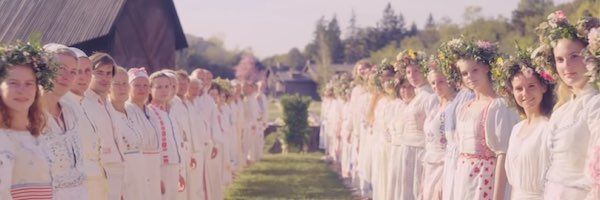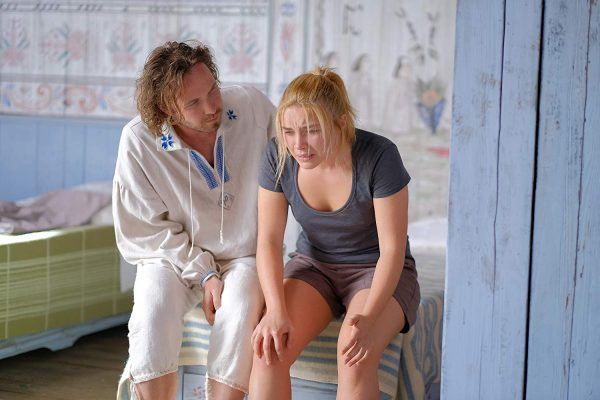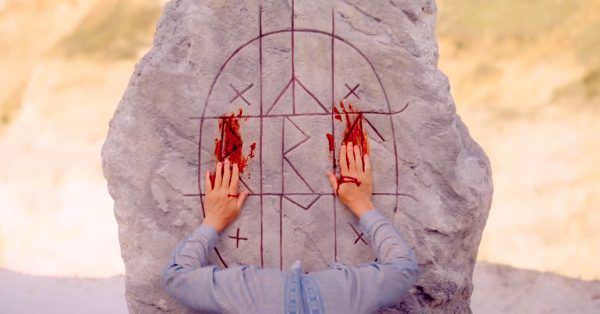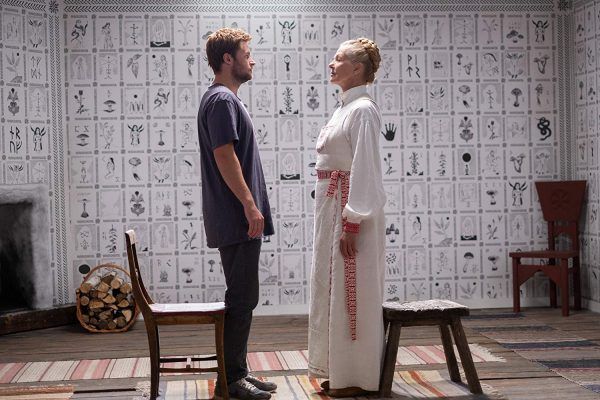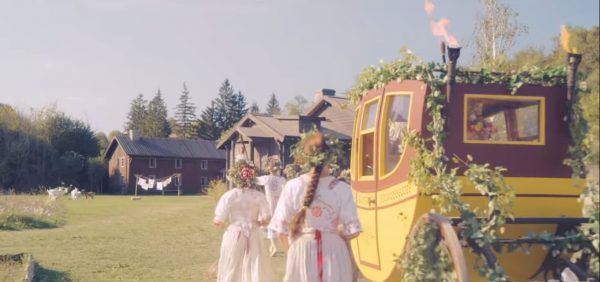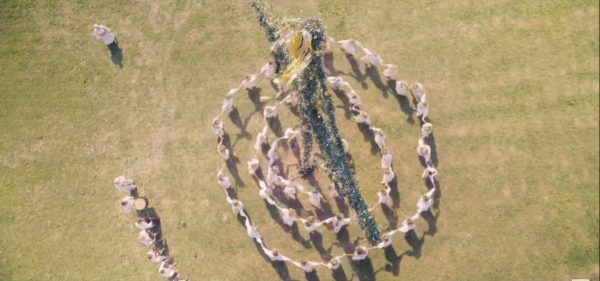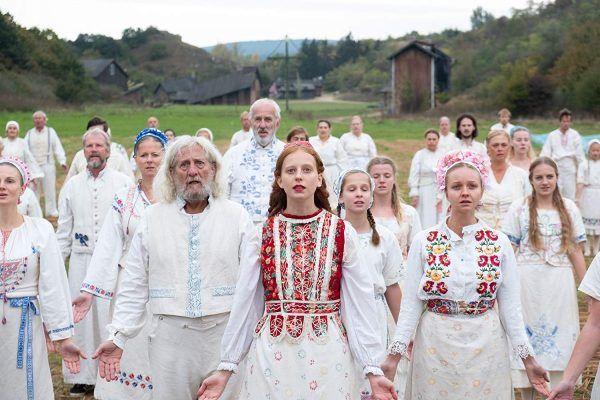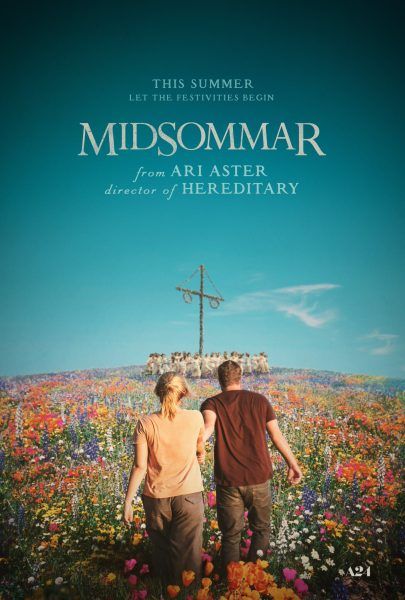Midsommar probably won't encourage folks to book tickets for a Swedish vacation anytime soon. What Ari Aster's new folk-horror film might do, however, is spark some curiosity as to the film's mythology and just how far it deviates from reality. The story centers on a group of Americans who travel to the Swedish hinterland at the invitation of their university friend in order to participate in a once-in-a-lifetime spring festival. What happens once they're there is something that's lost to legend and fiercely protected by the locals, but luckily we get to (safely) share in the festivities as the viewing audience.
Since both Hereditary and Midsommar lean heavily on pagan folklore, I was hoping that Aster either had roots in Nordic countries and culture or at least thoroughly researched it, like his PhD-candidate characters. Originally, B-Reel Films and producer Patrik Andersson brought Aster an idea for a folk horror picture centered on the concept of "Americans going to Sweden and getting killed off." But Aster was also going through a personal relationship break-up at the time and found a way to make "this big, operatic break-up movie" that "became very personal." Aster's take on the people of Hårga is that their culture is deeply rooted in reciprocity, which is an aspect that's missing in the core romantic relationship at the heart of the story; this is where the focus of Midsommar really lies.
But we're here to talk about the mythology and to find out just how much fact there is to this fiction. For example, though the movie is supposed to take place in the Swedish wilderness, it was filmed in Hungary; they did, however, have a Swedish costume designer and production designer. Additionally, Vanity Fair reported that, according to the movie's press notes, Aster brushed up on Swedish culture by collaborating with Stockholm-based set decorator Henrik Svensson on a 100-page reference document. Their research included visits to local folklore museums, tours of centuries-old farms with paintings on the walls similar to those found in the movie, and traditional cultural solstice celebrations, along with studies of British and German folklore. Aster also told the New York Times that the pre-Christian traditions found throughout the film were drawn from Scottish anthropologist James George Frazer's 1890 book "The Golden Bough: A Study in Comparative Religion."
But all of that research was more for aesthetics than accuracy. Swedish actor Vilhelm Blomgren, who plays Pelle, described Midsommar as "coming home" in a way. He confirmed that they eat pickled herring during their spring festivities, but that's about as far as the similarities go between reality and the movie's depiction of the pagan holiday. So from runes to ritual sacrifice, and maypoles to May Queens, here's a look at at what's real and what's stretching the truth quite a bit. Spoilers ahead for those of you who haven't seen Midsommar but still have a passing curiosity in Swedish festival lore.
Runes and Ritual Sacrifice
One reason to go back and rewatch Midsommar to catch the many and varied references scattered throughout the film. There's always something going on in the background, the layers of foreshadowing are many and varied, and the sheer beauty of the pagan artwork is at times as artistic as it is cryptic. And one very obvious pagan reference that pops up again and again over the course of the movie is the use of runes. Essentially an ancient alphabet used throughout Northern Europe before the adoption of the more modern Latin alphabet, runes are characters that have an associated sound as well as a meaning attributed to them. Pay special attention to when they show up on screen because they're representing more than just a tie to pagan lore.
For example, as The Week sums up, said runes are used in literal ways throughout the film, though it helps to know what they mean ahead of time. There's the upward arrow / T-shaped rune known as Tîwaz or Teiwaz that represents the Norse god Tyr, a brave and powerful male deity who sacrifices his arm to the giant wolf Fenrir. So who's the sacrificial character who gets to wear this rune? Christian (Jack Reynor), of course. The character's name is pretty on the nose when it comes to a religious analysis, but the runic associate is just as literal.
Other runes that show up include representations of secret initiations and tangible or intangible things inherited through the family line (which are seen on the paintings in the boarding house and the shape of the communal dining table), a rune for leadership (seen on the matriarch's dress), combined or "bound" runes in the sacrificial structure that mean fertility and procreation along with a gift of generosity or sacrifice, and, as seen on the rune stone above, an inverted rune (known as a "merkstave") which suggests a negative connotation of the rune's original meaning. In this case, the original meaning is one of divine blessing and protection; the inversion of it on the sacrificial stone is open to interpretation.
But perhaps the most interesting runes in the film are the two that Dani (Florence Pugh) has embroidered on her traditional dress. The R-shaped Raido represents a journey, but the reserve of it cam symbolize crisis or even death. The hourglass-like Dagaz suggests a new beginning, but since it's drawn on its side, it may represent the loss of hope; this particular meaning is also up for interpretation. Dani's journey throughout Midsommar certainly leads to a new beginning. Whether that new path is one of freedom and hopefulness or just a different sort of cage is up to each viewer to decide.
As for ritual human sacrifices, known as "blót", the history gets a little murkier here. There's the complicated history of Viking-era anthropological finds and the Christian propaganda that complicated stories of ritual sacrifices to Odin and other gods. Some accounts of the rituals claim they may have occurred once every nine years (rather than 90, as seen in the movie) and included sacrifices of humans (likely prisoners of war), livestock, dogs, and other animals on altars or through hanging. Anthropological finds, however, put a focus on sacrifices in wells; Odin was said to have given up one of his eyes in order to drink from Mimir's Well and thus gain its cosmic knowledge. Midsommar doesn't dip into this mythology much at all, but it is happy to put its own spin on ritual human sacrifice.
Welcome Spring with Valborg or Walpurgis Eve
Let's lighten things up a little, shall we? Not all festivals end in ritualistic suicide and murder. The Swedish celebration of Walpurgis Eve, celebrated since at least the Middle Ages, is a chance for people of all ages and professions to welcome in the Spring season. The public celebration, organized by towns, villages, and community groups, was historically held on April 30th. The actual celebrating was done through singing, dancing, and feasting (including a hearty dish of nettle soup), all around the bonfires (and long into the night). This is followed by a day of rest, either by sleeping or visiting a spa; May 1st has been a holiday in Sweden for 80 years. Those who wish to carry on the May Day celebration can participate in parades and march while displaying traditional slogans on banners.
Traditionally, a town's merchant class would prepare for the coming of Spring by trick-or-treating, dancing, singing, and sharing treats like eggs and schnapps. Sure, there was a bit of the old bureaucracy to the celebration as well since they would hold a village meeting and elect a new alderman, but the real fun was out in the field. The villagers would let their farm animals out to graze while lighting bonfires, firing guns, and making a bunch of noise to scare predators away. (*Fun fact: In Sweden, wasps are deadlier than most of the predators that might first come to mind.)
You can see elements of this idea in Midsommar: There's the focus on ritualized feasting and drinking, a very specific dancing sequence, and a metaphorical defeat of predators (be they the natural sort like bears or the spiritual sort likes demons), as well as the big bonfire which ends the whole movie with style.
May Day, Maypoles, and the May Queen
A lot of the traditional May Day celebrations have been shifted to the night before during "Last of April" festivities, and some of them have moved to Midsummer itself. Part of this reason for this is that May 1st is International Workers' Day. But the traditions still carry on in their own way. There's the decorating and raising of the maypole, a structure that has been theorized to represent everything from sacred trees, to the world axis, to phallic symbols. Traditionally, a dance around the maypole could have ended in the year's new May Queen. The May Queen herself is a personification of everything from youth and purity, to springtime and summertime, to ancient tree worship.
A big part of the plot of Midsommar reveals around this "election" of a new May Queen to make some pretty important decisions for the group and, eventually, possibly lead the matriarchal society. The dance in Midsommar that leads to the May Queen's coronation is based on the "Hårgalåten" folk song, which tells of the time a devil brought his fiddle to Hårga and forced everyone there to dance to the death, as the devil does. The creepy song goes on to say how everyone "forgot God and the whole world" during the dance, isolating them from everyone else. So Dani's successful survival of the dance suggests that not only has the devil been driven out of Hårga but that she's got an important part to play in community's future.
Midsummer
[EMBED_VIMEO]https://vimeo.com/39345149[/EMBED_VIMEO]
The actual Midsummer holiday is reason to celebrate in Sweden: It kicks off a five-week holiday where locals take advantage of every hour the relatively short summer season offers them. Folks in Sweden take this break so seriously, in fact, that they often close up shop and desert their towns and cities on Midsummer Eve. With all those folks heading out of town and into the countryside, the streets and thoroughfares get mighty busy; but at the end of the road (and a long line of cars), friends and family wait for the new arrivals with blooming, shimmering branches from silver birches.
Once out in the flowering fields on a Friday in late June, families and large gatherings of friends will start off their festivities by picking flowers, making wreaths, and raising the maypole, the site (and sight) of a number of "ring-around" dances. As for feasting, you could expect to see a variety of pickled herring; boiled potatoes with dill, sour cream, and chives; grilled dishes and barbecue; all topped off with fresh strawberries and cream. You can wash it all down with cold beer and spiced schnapps, accompanied by a drinking song or two (dozen). After all that, you might want to participate in a late-night but still sunlit dance by the lake or, if you'd like to be that romantic sort but don't have a significant other, go pick seven different flowers and lay them under your pillow; your future betrothed is supposed to appear in a dream.
On the more ancient and traditional side of Midsummer, some locals would dress themselves in ferns as "green men" to celebrate a season of fertility in the fields (and beyond). Houses, farms, and even farming tools got a green-up, too, with the flowering maypole at the center of all the festivities. Bonfires and visits to the healing waters of local spas were and continue to be a part of the celebration. And since the date remains the lightest and brightest night of the year, it lends itself to magical thinking: One could discover treasures by tracing moonbeams, learn of a future love by eating salted porridge to see who brings you water in your dreams, or find that water was turned to wine, ferns into flowers, and other plants gained healing properties. The tradition itself has become the country's most popular festival, but only in the last hundred years or so despite being in existence for more than a millennium.
Midsommar borrows heavily from these celebratory and romantic aspects of the festival, though Aster obviously adds a vicious edge to them all. The same goes for all of the traditional pagan folklore he borrowed from to bring a familiar and grounded edge to the ritualistic horror that befalls a group of wayward Americans. This is one movie that will be analyzed for years and years, so hopefully this mythology primer has given you cinephiles and film school students a solid start.

